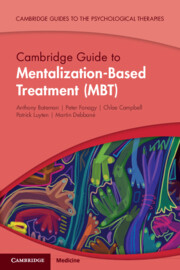Book contents
- Cambridge Guide to Mentalization-Based Treatment (MBT)
- Cambridge Guides to the Psychological Therapies
- Reviews
- Cambridge Guide to Mentalization-Based Treatment (MBT)
- Copyright page
- Contents
- Preface
- A Note from the Series Editor
- Acknowledgments
- Part I Overview of the Model
- Part II The Mentalization-Based Treatment Model in Practice
- Part III Application and Adaptations for Mental Health Presentations
- Chapter 6 Narcissistic Personality Disorder
- Chapter 7 Antisocial Personality Disorder
- Chapter 8 Avoidant Personality Disorder
- Chapter 9 Depression
- Chapter 10 Psychosis
- Chapter 11 Trauma
- Chapter 12 Eating Disorders
- Part IV Application of Mentalization-Based Treatment in Different Populations and in Different Settings
- Index
- References
Chapter 11 - Trauma
from Part III - Application and Adaptations for Mental Health Presentations
Published online by Cambridge University Press: 18 May 2023
- Cambridge Guide to Mentalization-Based Treatment (MBT)
- Cambridge Guides to the Psychological Therapies
- Reviews
- Cambridge Guide to Mentalization-Based Treatment (MBT)
- Copyright page
- Contents
- Preface
- A Note from the Series Editor
- Acknowledgments
- Part I Overview of the Model
- Part II The Mentalization-Based Treatment Model in Practice
- Part III Application and Adaptations for Mental Health Presentations
- Chapter 6 Narcissistic Personality Disorder
- Chapter 7 Antisocial Personality Disorder
- Chapter 8 Avoidant Personality Disorder
- Chapter 9 Depression
- Chapter 10 Psychosis
- Chapter 11 Trauma
- Chapter 12 Eating Disorders
- Part IV Application of Mentalization-Based Treatment in Different Populations and in Different Settings
- Index
- References
Summary
From a mentalizing perspective, in attachment trauma an individual’s experience of adversity is compounded by the sense that they have to be able to bear that experience alone. An overwhelming experience cannot be calibrated and managed within an attachment relationship. Normally another mind provides the social referencing that enables an individual to frame and reframe a frightening and potentially overwhelming experience. In the absence of this, the person cannot process the experience, and further development of mentalizing is disrupted. This chapter describes MBT-Trauma Focused (MBT-TF) work, and it illustrates the three phases of treatment by presenting clinical examples. Intervention focuses on mentalizing, avoidance, mental and behavioral systems, managing anxiety and dissociation, and trauma memory processing. An MBT intervention for complex PTSD that uses psychoeducation, group intervention, exposure, and looking to the future is outlined, and is illustrated with clinical examples.
Keywords
- Type
- Chapter
- Information
- Cambridge Guide to Mentalization-Based Treatment (MBT) , pp. 277 - 297Publisher: Cambridge University PressPrint publication year: 2023



